
- Home
- India
- World
- Premium
- THE FEDERAL SPECIAL
- Analysis
- States
- Perspective
- Videos
- Sports
- Education
- Entertainment
- Elections
- Features
- Health
- Business
- Series
- In memoriam: Sheikh Mujibur Rahman
- Bishnoi's Men
- NEET TANGLE
- Economy Series
- Earth Day
- Kashmir’s Frozen Turbulence
- India@75
- The legend of Ramjanmabhoomi
- Liberalisation@30
- How to tame a dragon
- Celebrating biodiversity
- Farm Matters
- 50 days of solitude
- Bringing Migrants Home
- Budget 2020
- Jharkhand Votes
- The Federal Investigates
- The Federal Impact
- Vanishing Sand
- Gandhi @ 150
- Andhra Today
- Field report
- Operation Gulmarg
- Pandemic @1 Mn in India
- The Federal Year-End
- The Zero Year
- Science
- Brand studio
- Newsletter
- Elections 2024
- Events
- Home
- IndiaIndia
- World
- Analysis
- StatesStates
- PerspectivePerspective
- VideosVideos
- Sports
- Education
- Entertainment
- ElectionsElections
- Features
- Health
- BusinessBusiness
- Premium
- Loading...
Premium - Events
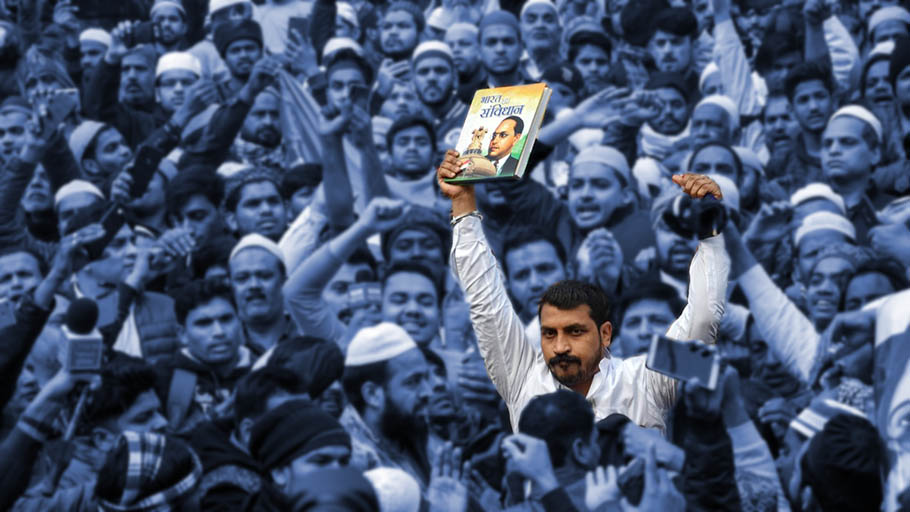
Can Ravan’s Bhim Army forge Dalit unity across India?

The world around Chandrashekhar Azad Ravan appears to be spinning very fast, like he is at the centre of a vortex. Pressure is growing from his supporters to turn the Bhim Army into a political party. According to many in his inner circle, he could launch a new national party as early as in March 2020. But given that his inner circle is very large, it is difficult to separate legend and...
The world around Chandrashekhar Azad Ravan appears to be spinning very fast, like he is at the centre of a vortex. Pressure is growing from his supporters to turn the Bhim Army into a political party.
According to many in his inner circle, he could launch a new national party as early as in March 2020. But given that his inner circle is very large, it is difficult to separate legend and nail facts.
For instance, he has a blood condition which requires him to undergo Phlebotomy every fortnight. The process involves drawing blood out of his system to prevent it from thickening and causing a heart attack. The legend, however, is simply that ‘Ravan produces too much blood when he is angry’.
The talk around him is that political offers have been streaming in from across the country ever since Ravan plunged into the anti-CAA protests. Dalit leaders from different political parties are said to be queuing up to offer support.
Left, liberal and Muslim groups, which are organizing the anti-CAA protests, are also asking for an appointment with the lawyer from Saharanpur but he has been difficult to track down. He has also been unpredictable.
We get a rare opportunity to look at the life of the Bhim Army founder from the inside-out for a few minutes on January 27 when he’s admitted at the Manipal Hospital in Dwarka. He’s just landed from Hyderabad where the Telangana police arrested and sent him back on a flight to Delhi.
It is a chance meeting. The person we’re actually following is another rising cult figure in Dalit-Bahujan-Ambedkarite circles — Radhika Vemula — the mother of Rohith Vemula. Just the previous day, on January 26 — Republic Day, she unfurled the tricolour along with the ‘grandmothers’ of Shaheen Bagh in front of lakhs of people.
She rushes out to meet Ravan as soon as she hears of his hospitalization. Radhika was accompanied by Saira Bano, the mother of Junaid Khan, the 15-year-old who was stabbed to death in a hate crime aboard a Mathura-bound train in June 2017. The two mothers had announced in Shaheen Bagh that they would take out a mother’s rally across India against the BJP government.
As the mothers shared their plans with Ravan in hushed tones, we try to speak to people close to him. There are at least a dozen men hovering around, his inner circle of guards-cum-advisers: mostly busy on the phone.
They seem to be receiving lots of calls. The hospital ward, where the doctor repeatedly called for silence, sounded like a call centre: “Which newspaper?” “What is the name of your party?” “Yes, we need more funds. Yes, and money. Lawyers too.”
It was strange that they were discussing these things so loudly in the presence of people who they had never met before. Like this reporter and many other journalists who had followed Radhika Vemula into the ward and goodness knows who else.
When asked, his team responds with the kind of bravado that has made the Bhim Army popular among young Dalit millennials across the country. They say they don’t believe in doing things secretly and attacking from the rear.
“Seena Taanke (chest out) What’s to hide? Everybody knows Ravan is the only answer to Ram,” says a person close to Ravan. He refuses to be drawn into the commenting on the details of the plan ahead. “The only thing we can talk about is the broad issue,” he says, “Only Ravan can decide when to launch the party and whose support to take.”
“Muslim parties, OBC parties, Communist parties and all sorts of political formations are after Ravan. They all know,” he says, “Things are often out of control because we are getting pulled in a hundred directions.”
He also corrects us when we call the Bhim Army a Dalit formation and presents the core ideology of the group: “We are a movement based on the Bahujan principle of Manyavar Kanshiram. We also believe in the Moolnivasi concept which says that the Bahujans are the true inhabitants of India. Recent DNA studies have further vindicated our worldview.”
Hyderabad confusion
The aide says that the core team is particularly stressed over the Hyderabad incident. The visit was planned in a hurry, he says, and there were many lapses in security.
Ravan’s supporters have been claiming that the arrest was at the behest of the All India Majlis-e-Ittehadul Muslimeen (AIMIM) which is part of the ruling coalition in Telangana. According to one version, the AIMIM wanted to host the Bhim Army in Telangana but on its own terms. Ravan was warned that he would be arrested if he tried to create a parallel platform and enter Hyderabad without an invitation.
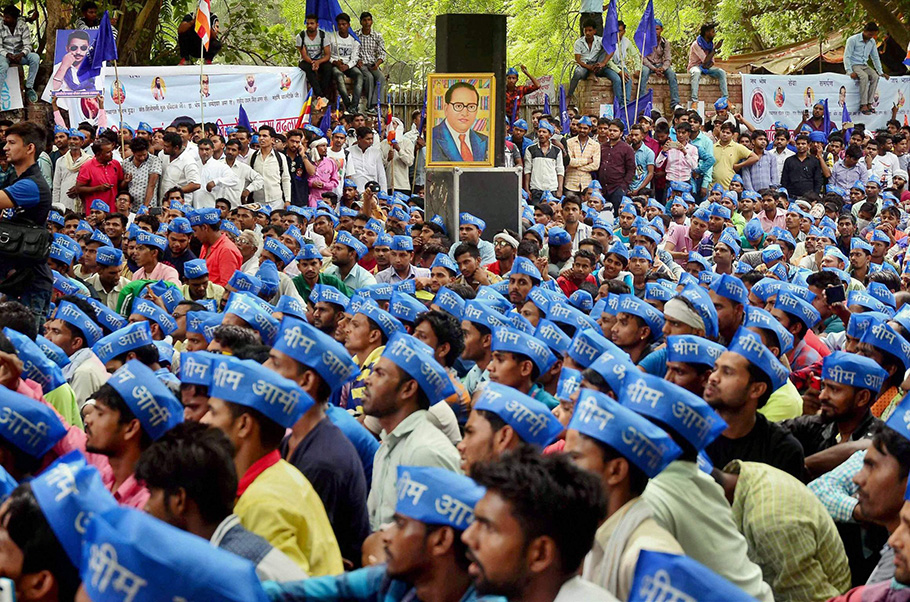
Sources say the Bhim Army team was invited to Hyderabad by a newly formed anti-CAA group called ‘Fraternity’ which was floated by the Students Islamic Organization (SIO), the student wing of the Welfare Party of India (WPI), which is the political wing of the Jamat-e-Islami Hind.
Bhim Army sources say they were under the impression that the Hyderabad group was part of the Rohith Vemula struggle. “We just blindly went,” says a source.
The impromptu Hyderabad visit has annoyed not just the AIMIM and Assaduddin Owaisi but also leaders of the Ambedkar Students Association (ASA) of the Hyderabad Central University (HCU). Rohith Vemula belonged to the ASA.
Although they weren’t invited for Ravan’s meeting, ASA sent out a delegation to meet him. They too were arrested.
“It was all one big disaster. Ravan has been thoroughly misguided. And the planning was very poor,” says senior ASA leader and PhD scholar Munna Sannaki who was arrested by the Hyderabad police when he tried to meet Ravan.
According to sources in the AIMIM, there was a lot of confusion. “We would have laid out the red carpet for him had he informed us properly,” says one leader. The AIMIM is now facing criticism for the detention and expulsion of Ravan.
However, Bhim Army leaders are eager to work with the Owaisi brothers. “We have a lot of respect for Assaduddin Owaisi saheb and the AIMIM. He is one of the tallest Muslim and Bahujan leaders in the country today. They are in touch with us,” says an older member of Ravan’s inner circle, wishing anonymity.
Conflict with Left
Things are clearly a little chaotic in the Bhim Army. Ravan was about to attend a CPI (M)-backed event in Kerala a few days ago but cancelled it at the last minute because of an outcry from Ambedkarite student groups, particularly in JNU and HCU.
A Dalit student leader from the Birsa Ambedkar Phule Students Association (BAPSA) in JNU says that his organization made a desperate, last-minute call to the people around Ravan to prevent him from going to Kerala.
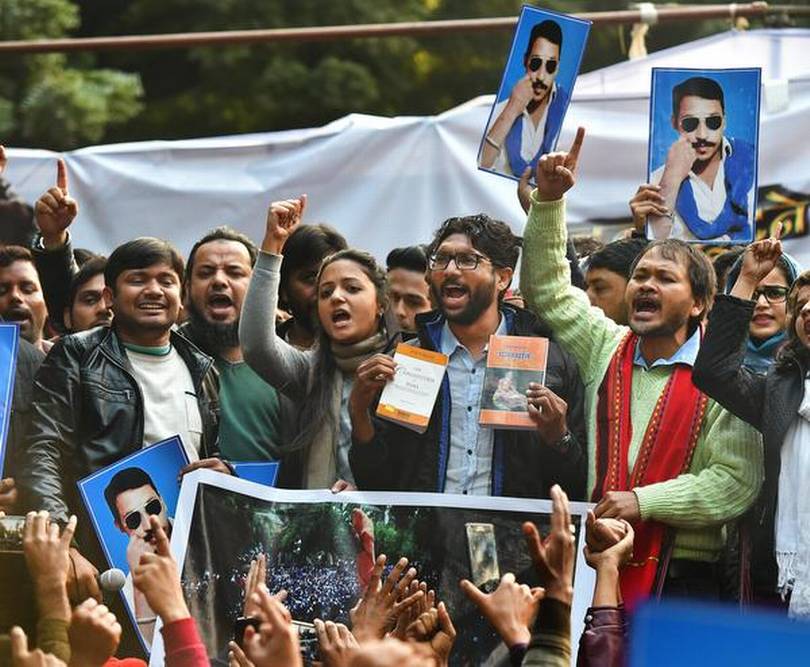
The historic conflict between the Left and Ambedkarite groups reached an all-time low during the Rohith Vemula movement. Groups such as BAPSA and the ASA fell out with Left groups, saying leaders such as Shehla Rashid, Umar Khalid and Kanhaiya Kumar had hijacked the anti-caste struggle triggered by Vemula’s death and the flogging of Dalits in Una, Gujarat.
“Bhim Army’s core team is only just venturing out of UP. They still have no idea of politics in the deep south or Maharashtra where things have changed a lot since the death of Rohith Vemula and the Una movement,” says the BAPSA leader. He says that many BAPSA leaders have been advising the Bhim Army but haven’t openly endorsed it because they are not sure which way Ravan will turn. “We don’t want to make the same mistake we made with Jignesh Mewani,” he says.
He says the group is not fully aware of the complexities of campus and identity politics in different parts of India. They are expanding at a very rapid pace. “Often, they do not know who they are mixing with,” says the JNU student, “They are still innocent and people in the larger anti-caste movement are yet to make up their minds about them.”
Taking on the elephant
In the Ambedkarite circles, Ravan is being closely watched because launching a political party would bring him in direct conflict with the Bahujan Samaj Party (BSP) and its leader Mayawati. Despite her recent electoral setbacks, she still is the tallest Dalit leader in the country.
And she has made her distaste for the group very clear and described them as a BJP ploy to weaken the Bahujan movement and the BSP.
Ravan, however, hasn’t responded to her jibes. He has also been silent about his political plans even as the Bhim Army expands rapidly across the country — 22 state units and counting. None of these units have attacked or criticized the BSP openly. But the people joining the Bhim Army in different states are mostly former BSP workers.
The last Dalit leader who rose to national prominence, Jignesh Mewani, alienated a large section of Ambedkarite groups after he identified with the Left ideology and allied with leaders such as Kanhaiya Kumar and Umar Khalid.
He also faced a major backlash from Dalits after he lampooned both Ambedkar and Mayawati at a speech in Hyderabad University a few years ago. In Ambedkarite circles, he is now viewed largely as a token Dalit propped up by the Congress and the Left.
The Bhim Army’s rise, on the other hand, is being watched with great interest in Ambedkarite circles because unlike Mewani, Ravan has remained within the framework of anti-caste politics and hasn’t toned himself down to accommodate upper-caste allies.
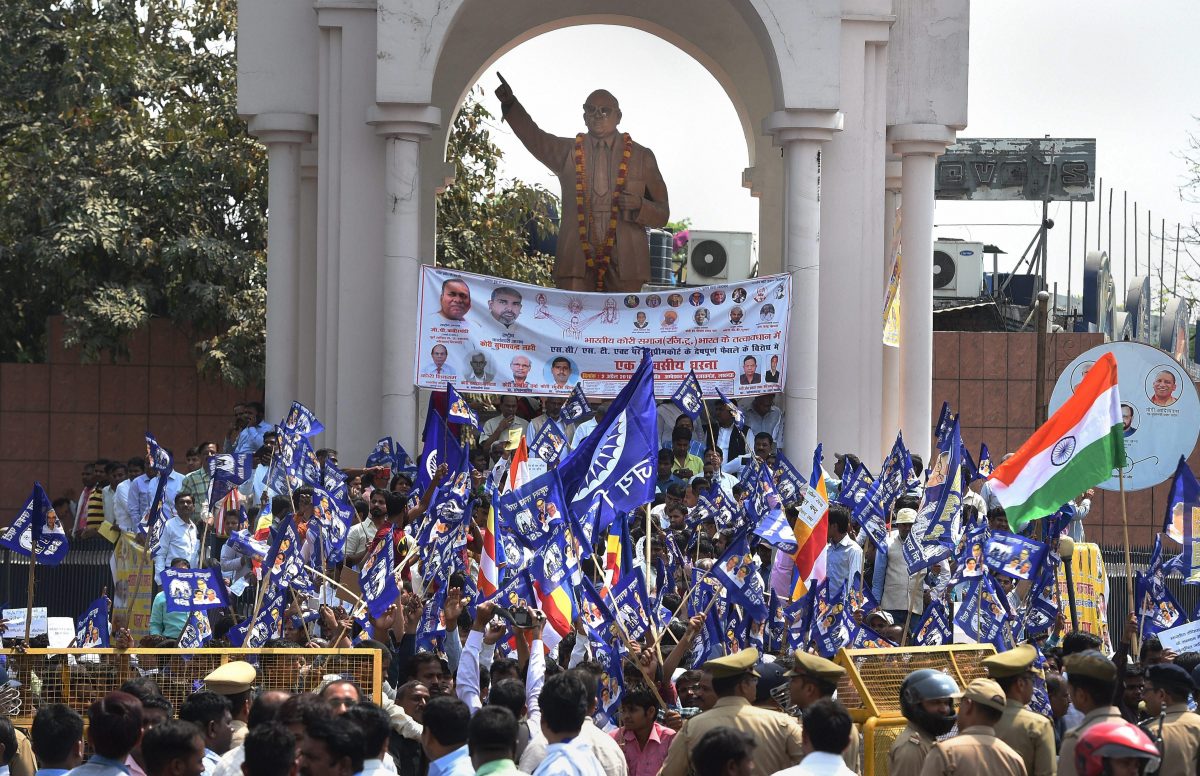
“We all respect Behenji Mayawati and will not speak against her. But it is becoming impossible to continue in the party. The wrong people are close to Behenji today. Young people want to act now,” one person in his circle says requesting anonymity.
There has been clearly widespread disenchantment with the BSP ever since Satish Mishra became Mayawati’s most trusted lieutenant.
This public deference and private criticism of Mayawati is common in the Bhim Army’s circles. They don’t criticize the party and its leader because Ravan has never made a statement criticizing the BSP or its chief Mayawati.
In fact, when he was asked about the bitter criticism of his group by Mayawati, Ravan had taken a TV anchor inside his house to reveal a poster of the Dalit icon, dressed in her classic pink salwar, alongside a bigger frame of BR Ambedkar.
“I don’t know why she is angry with me,” he had told the anchor in a March 2019 interview. However, it is apparent that the new Ambedkarite alternative that the Bhim Army is promising can only come at the cost of the established politics of the BSP and Mayawati.
Ravan’s supporters can’t stop talking about being approached by defectors from the BSP. They claim that at least half of the BSP MLAs in Uttar Pradesh are willing to quit and follow Ravan if he forms a party.
Mission education
One of the many people who claim to be in the inner circle of the organization, tells The Federal that the plan is to allow the Bhim Army to grow organically through its educational missions. “The Bhim Army will be like the ideological core, like the RSS, pure and powerful. The political party will be very different,” he says.
“Don’t forget that the basic foundation of the Bhim Army, the very reason for its meteoric rise, is the network of 300 after-schools they run for Dalit children in Western UP,” he says.
“The Bhim Army doesn’t exist on paper,” the source says, “It is not yet a registered organization. We can’t survive with the donations we get. Only when we become a national political party can we truly start serious fundraising.”
Another party leader says that it is just too much trouble to have a party with the word ‘Army’ in the name. There are forces bent on proving that the group is a militia, he says.”You can have ‘Sena’ in this country, not Army.”
Finding a name for the party that captures the imagination of people is the least of Ravan’s problems. At a time when the buzzword is Dalit-Muslim unity, Ravan’s real challenge is to first build Dalit unity. For that, he must first perform the unsavory task of uniting them against Mayawati.
The fact is, nobody since Mayawati and Kanshiram has been able unite Dalits on a pan-India level. In order to build an Ambedkarite organization and grow as a Dalit leader, Ravan and his followers know that they will have to invade the BSP’s territory. The winner of this face-off, whenever it happens, is most likely to script the future of Dalit politics in India.
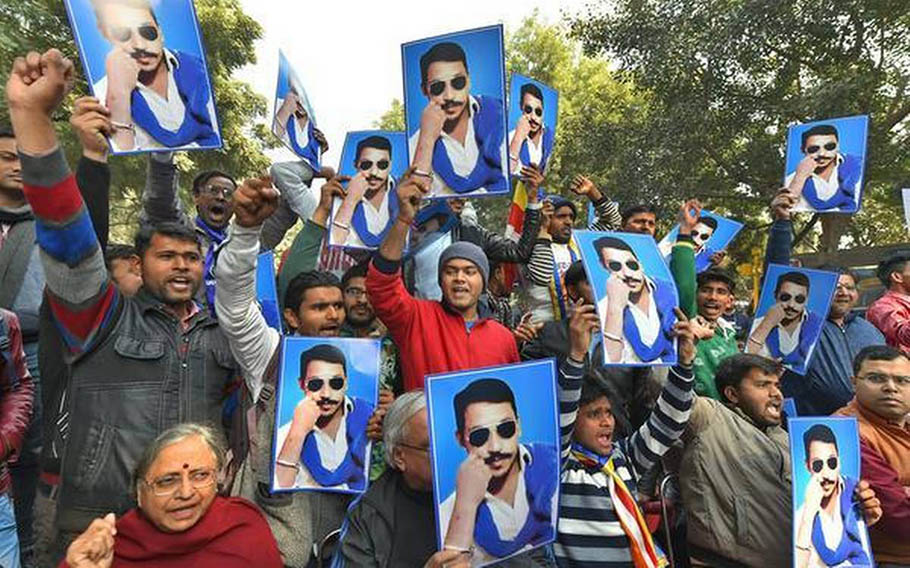
What women want
While Ravan’s daredevil and the manly image has won him many fans, many Dalit women scholars and intellectuals have expressed concerns about his hyper-masculine approach.
The rise of Radhika Vemula — who has gone on multiple tours of the country since Rohith’s death — has coincided with the emergence of a generation of Dalit women intellectuals in the public domain. Conversations around patriarchy are today at the centre of anti-caste politics because of this generation of women.
Ravan’s aides say that he is keen to shed the image that the Bhim Army is a male-dominated outfit. They say he is a big fan of Radhika Vemula. “Radhika Vemula can change the entire face of our organization if she decides to support us,” says the elder member.
However, when we speak to Radhika Vemula on her way out from the hospital, she is tight-lipped. Asked if Ravan would join her march or if she would join the Bhim Army, she tells reporters, “I just met him to check if he is OK. He reminds me of my son Rohith. It was just a mother-son meeting.”
Radhika Vemula enjoys widespread support from Dalits across the country and could turn out to be the game-changer for the Bhim Army as it tries to replace the BSP as a pan-India force. However, she dismisses the suggestion outright, “I will start my Mother’s yatra with the blessings of Behenji Mayawati. There is no way I am going to antagonize our greatest living icon.”
Despite their exhortations, Mayawati is unlikely to be impressed with the things Radhika and Ravan are doing. While condemning the Citizenship Amendment Act, she had instructed her followers to not join the ongoing agitations in the country and stay indoors. In a statement following the outbreak of protests, she had also slammed the UP police for its highhandedness.
There is surely a power vacuum in the Dalit political space but Ravan doesn’t appear big enough to fill it. But then, stranger things have happened in politics.
